Anglian Water’s Strategic Pipeline Alliance: Norwich to Wymondham Pipeline (2023)
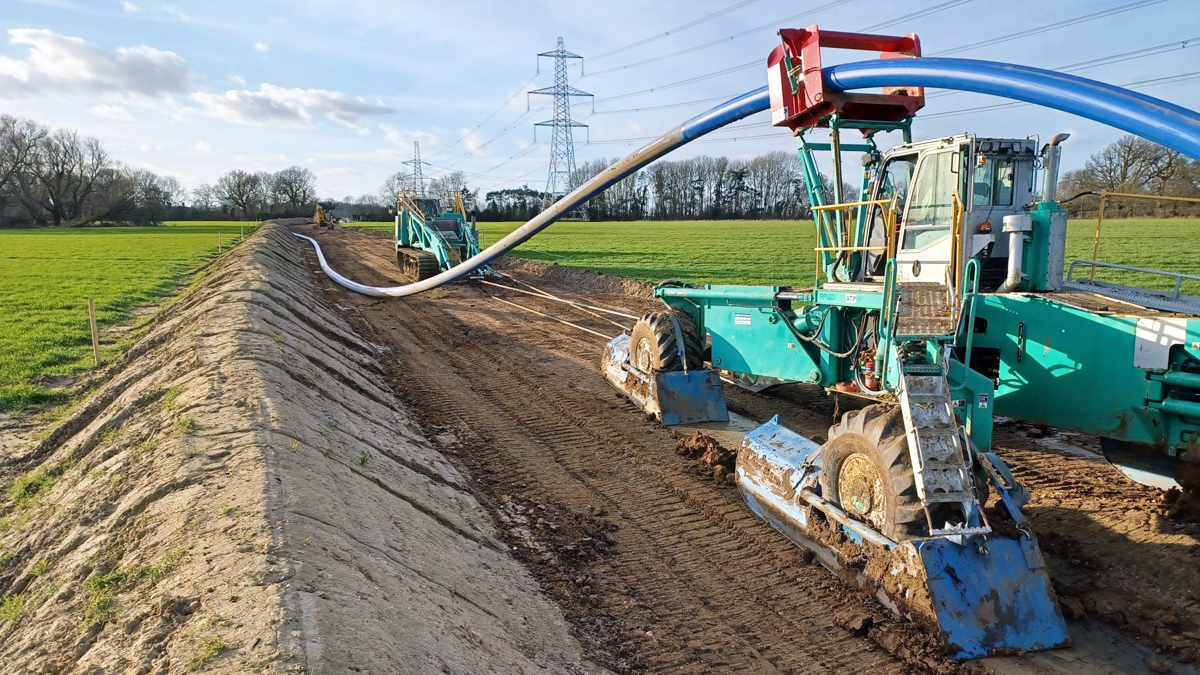
Pipe ploughing the OD 315mm PE100 pipe from Radius Systems with skis fitted - Courtesy of Anglian Water’s Strategic Pipeline Alliance
Anglian Water’s Strategic Pipeline Alliance (SPA) is delivering one of the largest infrastructure projects in AMP7; a new water main network, hundreds of kilometres long, which will allow Anglian Water to move water around the region from areas of surplus to areas of deficit, future-proofing supply to customers. The network is being constructed in 11 sections and pipelaying for the first two sections started in summer 2021; the 34km Lincoln-Grantham pipeline and the 12.5km Norwich-Wymondham pipeline. The SPA partners are Anglian Water, Costain, Farrans, AtkinsRéalis, Jacobs, and Mott MacDonald Bentley.
Pipe ploughing technique
Pipe ploughing is a technique that was developed for long distance cable duct laying, that has evolved and innovated into a method for laying pipes for potable water transmission and distribution pipelines across Europe and Australia.
Pipe ploughing causes minimal disruption to the ground, as the blades of the plough cut through the earth creating a precise trench and then immediately lays the pipe and backfills in one operation; meaning there is no need for digging or re-filling. It is a cleaner, greener, safer and more cost-effective way of laying water pipes.
When the pipeline route is across large fields, long lengths of pipe can be laid without interruption, with up to 1km achievable in just one day. When there are important environmental habitats and archaeological interests along the route, the narrower easement provided by the pipe plough reduces the number of surveys required and result in environmental improvements.
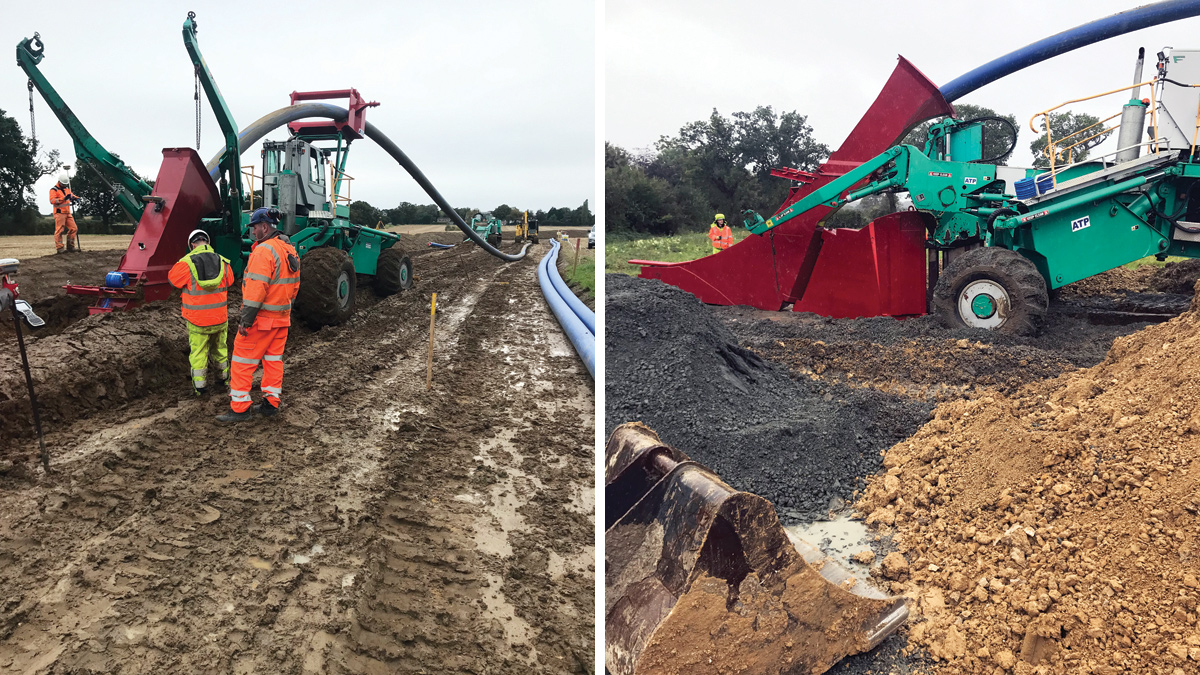
(left) Ground heave and (right) minimal ground disturbance during trial – Courtesy of SPA
Strategic Pipeline Alliance construction methodology trials
As this would be the first time in the UK that this method of pipelaying has been used for potable water pipes, Anglian Water’s Strategic Pipeline Alliance opted to trial the pipe ploughing methodology on a 1.1km section of the Norwich to Wymondham pipeline.
The trials were necessary to ensure key parameters for success of the main works were established, including trials to test compaction methods to ensure the pipe will be suitable for the design life. Concerns at the trial stage included:
- The final pipe embalmment characteristics.
- Scraping damage by stones.
- Ovality of the pipe; stresses from the installation method remaining in the pipe.
- Accuracy of pipe slope.
- Compaction of the soil heave caused by ploughing.
The pipe plough construction trial took place in October 2021. The compaction methods trials were undertaken in November 2021 and the Low Water Commissioning, water quality and pressure testing trials in January 2022. All concerns needed to be investigated thoroughly and key acceptance criteria were specified to be achieved before proceeding with the main works.
Embedment acceptance
The acceptance criteria for embedment were as follows:
- The allowable compaction of the bed and surround is to be minimum 85% measured by clegg hammer.
- Compaction of the backfill in the trench above the bedding and surround to be minimum 95%
- Any stones present in the bed and surround shall be assessed by the pipe manufacturer Radius Systems who will state their recommendation.
Other factors for the main works included rate of pipelaying, the depth of pipe in relation to the pulling force and ground heave, easement width, disturbance to the landowners’ field, and the accuracy of laying.
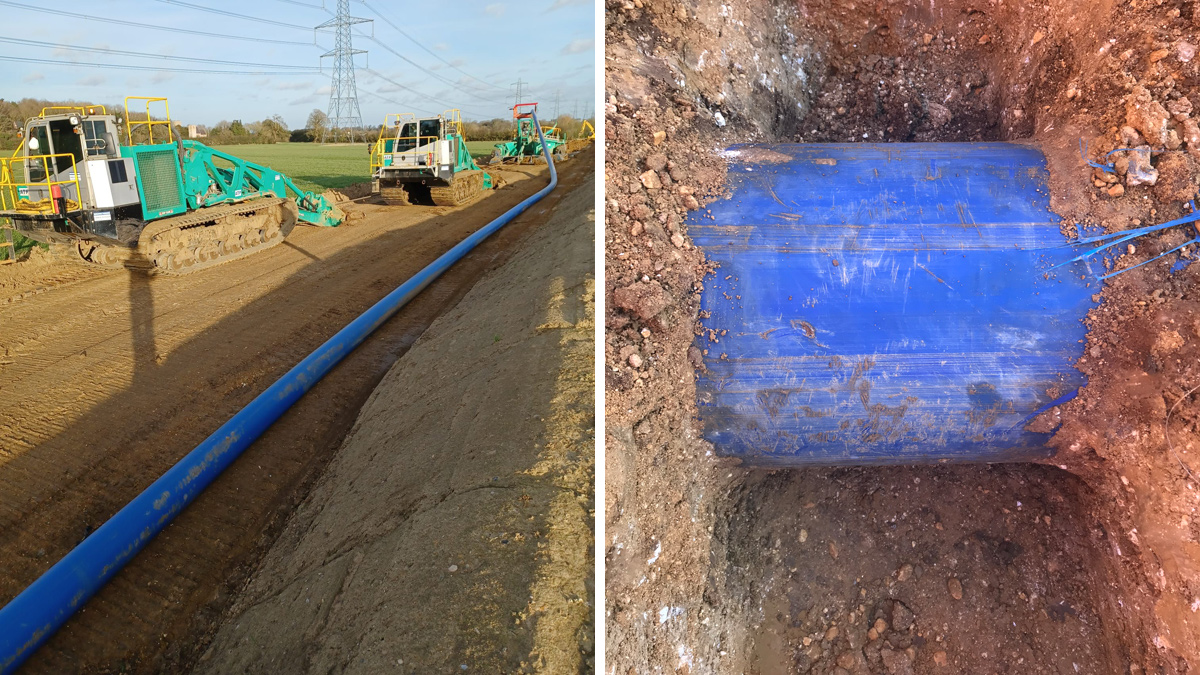
(left) Two winches in use and (right) excavation of ploughed pipe to test compaction and scraping – Courtesy of SPA
Compaction methodology
Following the trials, the selected compaction methodology was as follows:
- 13 ton excavator with a compaction plate fitted to it follows behind the plough whacking the open trench that the plough leaves. (5 passes of 2100 kg plate).
- Followed by a 21 ton excavator pulling into the trench the heaved soil in layers no deeper than 200mm.
- Again the 13 ton excavator will whack the trench with vibrating plate.
- Finally, the last of the spoil is levelled through and tracked in using the 21 ton excavator.
Structural design of the pipe
For the structural design of the pipe, calculations were carried out in accordance with BS9295:2020. Given that pipe ploughing is a trenchless technique, the worst-case pipe embedment condition of unsupported (S4) was selected.
The geotechnical investigation indicated that most of the ground would be Spanglers modulus (SI) of 1 or greater. Where the ground was found to be softer, then trenched embedment class S1 was used. An SDR 13.6 (12.5 bar pressure rating) pipe was calculated to be acceptable for this situation of S4 embedment class, 10.6 bar operating pressure, and SI equal to 1, however an increased SDR rating of SDR 11, which is 20% thicker than the SDR 13.6 pipe was selected for the following reasons:
- The presence of stones in the bed and surround.
- The compactive effort needed to compact the plough heave.
- Scraping of the pipe against stones during installation.
- Strength in the unsupported condition.
Low Water Commissioning, water quality & pressure testing trials
To ensure the pipe met the Key Decision Criteria for proceeding to the main pipe section, the trial pipe was cleaned, disinfected and pressure tested using a method of Low Water Commissioning that was under test and development by SPA, and deviations to AW standards were developed to deliver this new commissioning strategy ‘deliberately delivering differently’.
To clean the pipe, the pipe was air swabbed using dual swabs with wash water between. The wash water consisting of up to 1% pipeline volume of potable water dosed up to 10ppm chlorine content driven by clean, filtered, and cooled air, applying less than 1.5 bar air pressure. The first swab was very dirty, but after only two more swab runs the wash water was with less than 10 NTU and sufficiently clean to commence air disinfection.
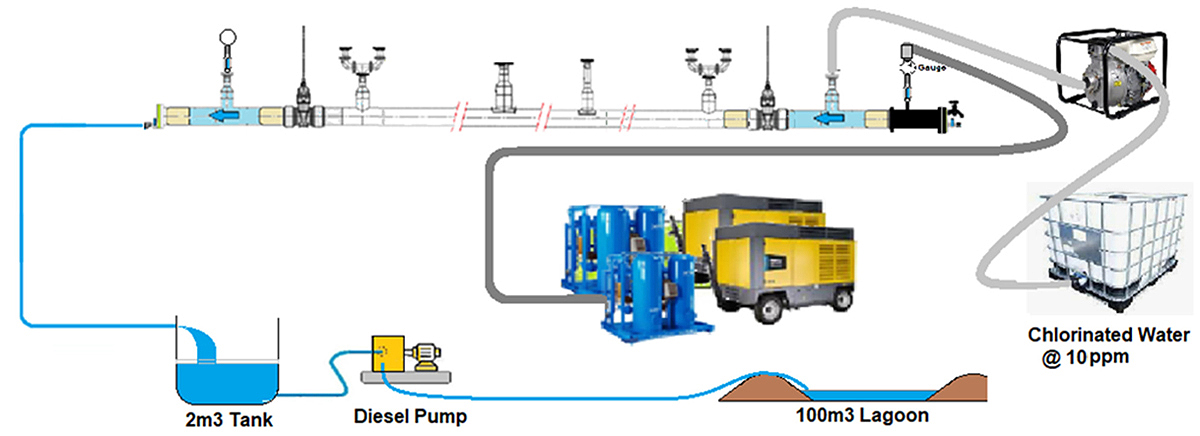
Air swabbing schematic for Low Water Commissioning – Courtesy of SPA
Under the normal Anglian Water standards for swabbing this would have taken three pipe volumes of water to achieve, the water savings for SPA using the air swabbing techniques is therefore enormous. The pipe was then disinfected by a slug of super-chlorinated water, introduced between two swabs and driven at a low speed through the pipeline by air. The trial pipe was then filled with drinking water and then pressure tested to 1.5 times the maximum operating pressure. The pressure test passed first time.
Finally water quality samples were taken to ensure that it could be put into service as a water supply pipeline and further significant water savings were made at this stage.
Kevin Ensell, part of the SPA team who spearheaded the strategy said:
“Low Water Commissioning in particular is an environmentally friendly, cost-effective solution that is transforming Anglian Water’s work and an innovation we anticipate will be adopted across the water industry”.
Norwich to Wymondham – main works construction
The Norwich to Wymondham pipeline runs from Little Melton (east of the Norwich Southern Bypass) to the existing High Oak Reservoir, near Wymondham.
Following the successful trials, the pipe plough methodology was selected as the optimum method of pipelaying the full length (12.5km) of the main works.
Under the supervision of the main contractor Mott MacDonald Bentley (MMB), specialist contractor ATP Cable Plough undertook the pipelaying using a ‘Spider Plough’ manufactured by the Föckersperger Group in Germany. The ‘Spider Plough’ was towed by a crawler winch pulling at a force of 180 tonnes with the front of the crawler sunk into the ground.
Norwich to Wymondham Pipeline: Supply chain – key participants
- Client: Anglian Water
- Delivery partner: Strategic Pipeline Alliance
- Anglian Water | Costain | Farrans | AtkinsRéalis | Jacobs | MMB
- Main contractor: Mott MacDonald Bentley
- Specialist contractor: ATP Cable Plough
- HDPE pipe: Radius Systems
- Pipe plough manufacturer: Föckersperger Group
Lessons learned
As a result of the trials and completion of the main works the following lessons were learned:
- An up and over method of installation of the pipe is preferable to looped method.
- In wet conditions ski shoes fitted to the wheels of the plough rigger reduce damage to the land.
- At depths greater than 2m the pulling force on the plough is high and the heave is large, minimise depth when possible.
- An easement width of more than 20m is recommended for the pipe plough and wider where trenched excavation is needed to cross roads and utilities.
- On pipe strength grade higher than needed to provide extra strength to allow for stones and compactive effort.
- Planning the length of pipe strings to reduce the number of post installation joints.
- Pre-construction land drainage to be installed.
- Tight end caps in temporary situation to prevent contamination and maintain high, food-grade hygiene standards.
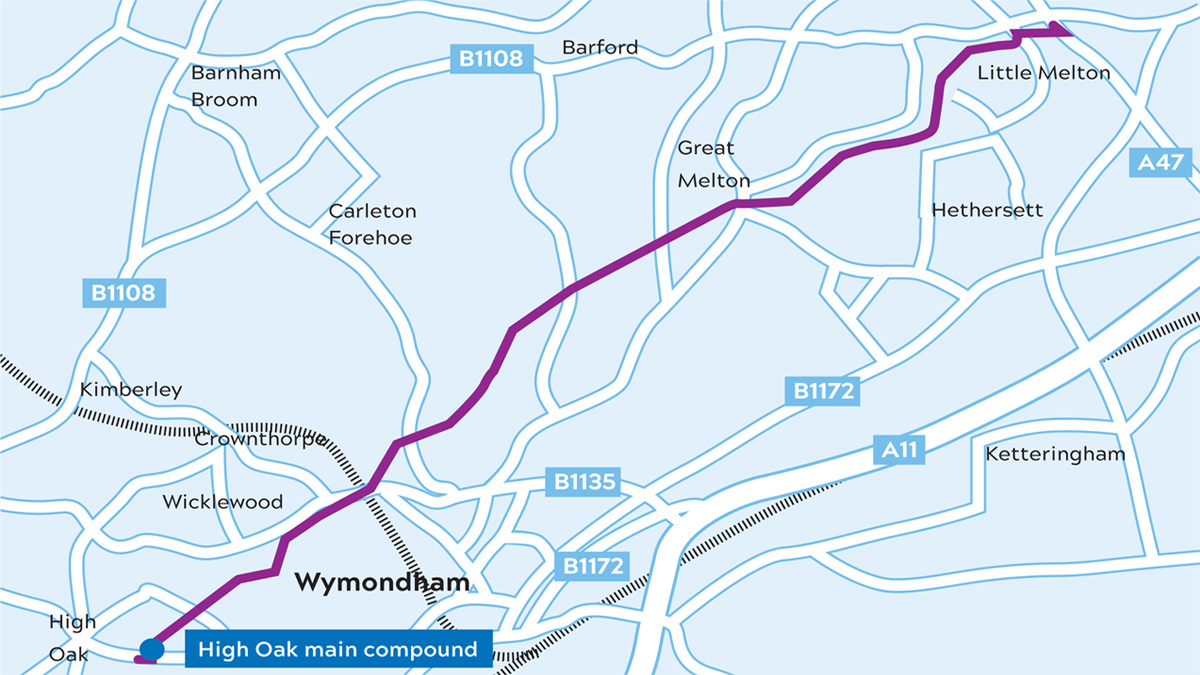
Route of the Norwich to Wymondham pipeline – Courtesy of SPA
Conclusion
Construction of the 12.5km, 315mm outside diameter high density polyethylene pipe (PE100) Norwich to Wymondham Pipeline was completed in April 2022. The pipeline (including the 1.1km trial length) was commissioned successfully, passing the pressure test first time and achieving the required water quality to put into supply without incurring delay. Air swabbing for the main pipeline was carried out in sections of not more than 5km length, and the full length of pipeline was pressure tested in one go. The pipeline can now deliver 58 l/s of potable water during critical periods of operation.
Key to the success was the flange management strategy implemented by the team to ensure the quality of jointing and the food-grade hygiene strategy ensuring that maximum hygienic practices were undertaken so that drinking water quality was the highest standard and the least amount of water used, saving water and achieving a highly sustainable result.






